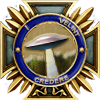Captain Marvel’s origin has ties to the MCU’s earliest days
The Tesseract debuts in Captain America: The First Avenger
Though not the first on-screen appearance —
Thor’s post-credits scene preceded it by a few months — the Tesseract became a major plot device in 2011’s
Captain America: The First Avenger. The movie opens when a group of Nazis / HYDRA soldiers led by Johann Schmidt (aka Red Skull) track the Tesseract to a church in Norway. Schmidt, whose knowledge of its existence seems to come from mythology, then takes the Tesseract and, along with co-conspirator Armin Zola, develop weapons that harness Tesseract’s energy.
Ultimately, Steve Rogers (aka Captain America) foiled those plans when he infiltrated an aircraft packed with the Red Skull, the Tesseract, and several nuclear bombs. In the end, Red Skull tries to physically hold the Cosmic Cube, which — as we learn in
Avengers: Infinity War — teleports him through space to the planet Vormir, where Thanos eventually sacrifices Gamora.
Post-wormhole, the Tesseract burns through the aircraft and falls into ocean, where it is later retrieved by Howard Stark (aka Iron Man’s dad, one of the many important dads in the MCU) while searching for Rogers. At some point, between then and 1989, the Tesseract finds itself at Project PEGASUS, a joint effort by NASA and the US Air Force to study the Tesseract. We’ll have to wait until the next Marvel prequel to know what happened to the Tesseract during the 45-year gap in MCU history
Captain Marvel and Project PEGASUS (part one)
The Tesseract’s importance in
Captain Marvel’s story isn’t revealed until later in the movie, after Carol Danvers regains her memories. Prior to the events of the film, Mar-Vell (Annette Bening) joins Project PEGASUS under the guise of an aerospace engineer named Dr. Lawson. She ultimately gains possession of the Tesseract, storing it in a hidden lab orbiting Earth. Mar-Vell, a Kree scientist
helping refugee Skrulls escape the horrors of war, works to create a faster-than-light (FTL) engine powered by an “energy core” that harnesses the Tesseract’s power.
As revealed in flashbacks, Danvers was the pilot of an experimental plane (special energy engine in tow) that escorted Lawson / Mar-Vell. As we see in flashback, the Kree operative Yon-Rogg (Jude Law) shoots down the plane in order to steal the technology. Danvers, acting on Mar-Vell’s dying wish, blows up the engine so that the Kree would not be able to obtain it. The resulting explosion bathes Carol in energy from the Tesseract, granting her powers. Yon-Rogg brings Danvers into the Kree fold, her memories pre-explosion missing, while also implanting a power-dampening chip in her neck.
Back to the present, Danvers — along with Nick Fury and Mar-Vell’s
alien cat / flerken Goose — travel to the orbital lab and find the source of this faster-than-light power: the all-too-familiar blue cube (to the audience, at least — the characters are understandably not as familiar). A battle with the Kree ensues, during which Goose swallows the Tesseract. We next see the Tesseract
in Captain Marvel’s post-credits scene, when Goose barfs it up.














